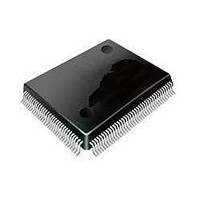ST92F120V1Q7 STMicroelectronics, ST92F120V1Q7 Datasheet - Page 187

ST92F120V1Q7
Manufacturer Part Number
ST92F120V1Q7
Description
Microcontrollers (MCU) Flash 128K SPI/I2C
Manufacturer
STMicroelectronics
Datasheet
1.ST92F120V9Q7.pdf
(325 pages)
Specifications of ST92F120V1Q7
Data Bus Width
8 bit, 16 bit
Program Memory Type
Flash
Program Memory Size
128 KB
Data Ram Size
4 KB
Interface Type
I2C, SPI
Maximum Clock Frequency
24 MHz
Number Of Programmable I/os
77
Number Of Timers
5
Maximum Operating Temperature
+ 105 C
Mounting Style
SMD/SMT
Package / Case
PQFP-100
Minimum Operating Temperature
- 40 C
On-chip Adc
8 bit, 16 Channel
Lead Free Status / Rohs Status
No
Available stocks
Company
Part Number
Manufacturer
Quantity
Price
Company:
Part Number:
ST92F120V1Q7
Manufacturer:
ST
Quantity:
6 765
Part Number:
ST92F120V1Q7
Manufacturer:
ST
Quantity:
20 000
Part Number:
ST92F120V1Q7C
Manufacturer:
ST
Quantity:
20 000
Company:
Part Number:
ST92F120V1Q7DTR
Manufacturer:
MAXIM
Quantity:
2 854
- Current page: 187 of 325
- Download datasheet (3Mb)
MULTIPROTOCOL SERIAL COMMUNICATIONS INTERFACE (Cont’d)
10.5.6 Clocks And Serial Transmission Rates
The communication bit rate of the SCI transmitter
and receiver sections can be provided from the in-
ternal Baud Rate Generator or from external
sources. The bit rate clock is divided by 16 in
Asynchronous mode (CD in CCR reset), or undi-
vided in the 3 other modes (CD set).
With INTCLK running at 24MHz and no external
Clock provided, a maximum bit rate of 3MBaud
and 750KBaud is available in undivided and divide
by-16-mode respectively.
With INTCLK running at 24MHz and an external
Clock provided through the RXCLK/TXCLK lines,
a maximum bit rate of 3MBaud and 375KBaud is
available in undivided and divided by 16 mode re-
spectively (see Figure 10).
External Clock Sources. The External Clock in-
put pin TXCLK may be programmed by the XTCLK
and OCLK bits in the CCR register as: the transmit
clock input, Baud Rate Generator output (allowing
an external divider circuit to provide the receive
clock for split rate transmit and receive), or as
CLKOUT output in Synchronous and Serial Ex-
pansion modes. The RXCLK Receive clock input
is enabled by the XRX bit, this input should be set
in accordance with the setting of the CD bit.
Baud Rate Generator. The internal Baud Rate
Generator consists of a 16-bit programmable di-
vide by “N” counter which can be used to generate
the transmitter and/or receiver clocks. The mini-
mum baud rate divisor is 2 and the maximum divi-
sor is 2
tor, the divisor value is immediately loaded into the
counter. This prevents potentially long random
counts on the initial load.
The Baud Rate generator frequency is equal to the
Input Clock frequency divided by the Divisor value.
WARNING: Programming the baud rate divider to
0 or 1 will stop the divider.
Figure 96. SCI-M Baud Rate Generator Initialization Sequence
16
-1. After initialising the baud rate genera-
MULTIPROTOCOL SERIAL COMMUNICATIONS INTERFACE (SCI-M)
BYTE INITIALIZATION
BYTE INITIALIZATION
LEAST SIGNIFICANT
MOST SIGNIFICANT
WORKING MODE
SELECT SCI
The output of the Baud Rate generator has a pre-
cise 50% duty cycle. The Baud Rate generator can
use INTCLK for the input clock source. In this
case, INTCLK (and therefore the MCU Xtal)
should be chosen to provide a suitable frequency
for division by the Baud Rate Generator to give the
required transmit and receive bit rates. Suitable
INTCLK frequencies and the respective divider
values for standard Baud rates are shown in
2.
10.5.7 SCI -M Initialization Procedure
Writing to either of the two Baud Rate Generator
Registers immediately disables and resets the SCI
baud rate generator, as well as the transmitter and
receiver circuitry.
After writing to the second Baud Rate Generator
Register, the transmitter and receiver circuits are
enabled. The Baud Rate Generator will load the
new value and start counting.
To initialize the SCI, the user should first initialize
the most significant byte of the Baud Rate Gener-
ator Register; this will reset all SCI circuitry. The
user should then initialize all other SCI registers
(SICR/SOCR included) for the desired operating
mode and then, to enable the SCI, he should ini-
tialize the least significant byte Baud Rate Gener-
ator Register.
'On-the-Fly' modifications of the control registers'
content during transmitter/receiver operations, al-
though possible, can corrupt data and produce un-
desirable spikes on the I/O lines (data, clock and
control). Furthermore, modifying the control regis-
ters' content without reinitialising the SCI circuitry
(during stand-by cycles, waiting to transmit or re-
ceive data) must be kept carefully under control by
software to avoid spurious data being transmitted
or received.
Note: For synchronous receive operation, the data
and receive clock must not exhibit significant skew
between clock and data. The received data and
clock are internally synchronized to INTCLK.
187/324
Table
9
Related parts for ST92F120V1Q7
Image
Part Number
Description
Manufacturer
Datasheet
Request
R

Part Number:
Description:
8/16-bit Flash Mcu Family With Ram, Eeprom And J1850 Blpd
Manufacturer:
STMicroelectronics
Datasheet:

Part Number:
Description:
STMicroelectronics [RIPPLE-CARRY BINARY COUNTER/DIVIDERS]
Manufacturer:
STMicroelectronics
Datasheet:

Part Number:
Description:
STMicroelectronics [LIQUID-CRYSTAL DISPLAY DRIVERS]
Manufacturer:
STMicroelectronics
Datasheet:

Part Number:
Description:
BOARD EVAL FOR MEMS SENSORS
Manufacturer:
STMicroelectronics
Datasheet:

Part Number:
Description:
NPN TRANSISTOR POWER MODULE
Manufacturer:
STMicroelectronics
Datasheet:

Part Number:
Description:
TURBOSWITCH ULTRA-FAST HIGH VOLTAGE DIODE
Manufacturer:
STMicroelectronics
Datasheet:

Part Number:
Description:
Manufacturer:
STMicroelectronics
Datasheet:

Part Number:
Description:
DIODE / SCR MODULE
Manufacturer:
STMicroelectronics
Datasheet:

Part Number:
Description:
DIODE / SCR MODULE
Manufacturer:
STMicroelectronics
Datasheet:

Part Number:
Description:
Search -----> STE16N100
Manufacturer:
STMicroelectronics
Datasheet:

Part Number:
Description:
Search ---> STE53NA50
Manufacturer:
STMicroelectronics
Datasheet:

Part Number:
Description:
NPN Transistor Power Module
Manufacturer:
STMicroelectronics
Datasheet:











